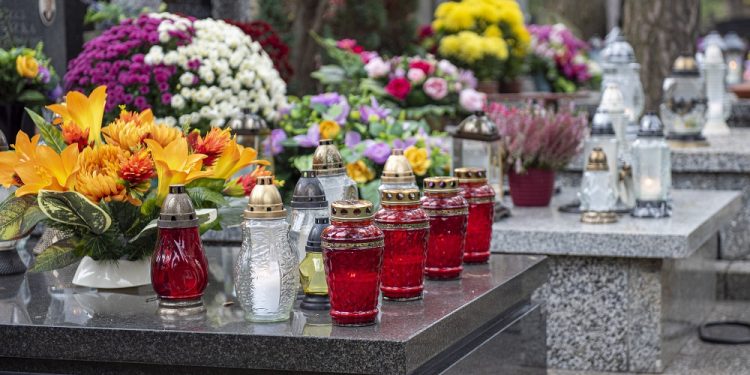
All Saints’ Day
According to the Merriam-Webster Dictionary, a saint is “one officially recognized especially through canonization as preeminent for holiness; one of the spirits of the departed in heaven; one of God’s chosen and usually Christian people; one eminent for piety or virtue.”
Each religion incorporates the term saint in different ways. The following history describes how saints became known to the Christian religion and, as years passed, into the Catholic religion. Throughout history, since the time of Jesus, other religions have used the term ‘saints’ according to each religion’s beliefs. Other religions’ celebration or non-celebration of All Saints’ Day is listed below.
Christian History
Early in the 1st century, Jesus began His teachings on this Earth about His Father, the Lord God. The initial believers (followers) were the twelve apostles listed in the Book of Saint Mark 3:16-19 in the Holy Bible. After the many teachings of Jesus and the many miracles He performed, more and more people became believers (followers).
As Jesus was given the name of Jesus Christ or translated, Jesus ‘the anointed one’, the believers (followers) became known as Christians. Prior to 313 A.D., the early Christians kept the practice of their religion secret because if known, they would have been persecuted, sometimes in large groups, by the Romans.
Early in the fourth century, Christianity became a legitimate religion. “The situation changed in 313 A.D. when Emperor Constantine made Christianity a licit religion of the Roman Empire.” Christianity continued to spread throughout the lands, including into the European countries, the Middle Eastern countries, and into Asia Minor.
The early persecuted Christians were considered martyrs and, in the early days, called saints. There were so many people who were martyred during the first, second, and third centuries that the local churches called for one day to honor the many “saints” who suffered for Christianity.
In the year 373 AD, a feast honoring all “saints” who were martyred for practicing Christianity occurred. During the early years of celebration, the feast was held around the time of the Easter season. “The first reference to a general feast celebrating all saints occurs in St. Ephrem the Syrian (d. AD 373). St. John Chrysostom (d. AD 407) assigned a day to the feast, the first Sunday after Pentecost, where in the Eastern Churches the feast is celebrated to this day.”
Saint Peter’s Basilica
It is believed that the Roman Catholics also celebrated the feast during the Easter season until the early 8th century. Pope Gregory III, who was pope from 731-741, dedicated a chapel in St. Peter’s Basilica for all Christian martyrs of the past centuries. It is believed that the dedication occurred on November 1.
It is uncertain as to who proclaimed November 1st to be All Saints’ Day; however, the following items have been listed as factual occurrences leading to the formation of an All Saints’ Day celebration for the Roman Catholics on November 1st of each year:
- St. Bede (d. 735) recorded the celebration of All Saints’ Day on Nov. 1 in England.
- Ado of Vienne (d. 875) recounted how Pope Gregory IV asked King Louis the Pious (778-840) to proclaim Nov. 1 as All Saints’ Day throughout the Holy Roman Empire.
- According to an early Church historian, John Beleth, Pope Gregory IV (827-844) officially declared Nov. 1 the Feast of All Saints, transferring it from May 13.
- Sicard of Cremona (d. 1215) recorded that Pope Gregory VII (1073-85) finally suppressed May 13 and mandated Nov. 1 as the date to celebrate the Feast of All Saints.
As there have been so many people called saints throughout history, an actual number of saints is not known. “There are over 10,000 named saints and beati from history, the Roman Martyrology, and Orthodox sources, but no definitive ‘head count’.”
From the tenth century until 1983, saints within the Roman Catholic Church “were chosen by public acclaim. Though this was a more democratic way to recognize saints, some saints’ stories were distorted by legend, and some never existed.”
Pope John Paul II (Pope from 1978 to 2005) changed the process for becoming a saint. Popular opinion was no longer the determinate factor for becoming a saint. Many steps are now taken to ensure that sainthood is held for only those who truly deserve the title.
Saints of other Christian Religions
In the Greek Orthodox religion, All Saints’ Day is celebrated on the first Sunday after Holy Pentecost. “This day has been designated as a commemoration of all of the Saints, all the Righteous, the Prophets, Apostles, Martyrs, Confessors, Shepherds, Teachers, and Holy Monastics, both men and women alike, known and unknown, who have been added to the choirs of the Saints and shall be added from the time of Adam until the end of the world, who have been perfected in piety and have glorified God by their holy lives.”
The Russian Orthodox religion also celebrates All Saints’ Sunday on the first Sunday after Holy Pentecost. Emperor Leo VI the Wise was married to Theophano, a woman of great charity and caring. After her death, Emperor Leo VI built a church to honor her. However, he was “forbidden from dedicating it to his wife, [and] dedicated it to All Saints, so that his wife would be honored as a righteous woman.
He also issued a decree on the date of the feast.” The Protestant religion believes that anyone who has converted to Christianity is considered to be a saint. “In this sense, anyone who is within the Body of Christ (i.e., a professing Christian) is a ‘saint’ because of their relationship with Christ Jesus.” Regarding the religion of The Church of Jesus Christ of Latter-day Saints, the church “is a Christian church but is neither Catholic nor Protestant.
Rather, it is a restoration of the Church of Jesus Christ as originally established by the Savior in the New Testament of the Bible.” The church uses the word ‘saint’ in the original context, which is ‘as a follower of Christ’. The parishioners do not pray to any saints; they only pray to God in the name of Jesus Christ.
Within the Lutheran religion, All Saints’ Day is celebrated on November 1st. For the parishioners within this religion, “the day is observed by remembering and thanking God for all saints, both dead and living. It is a day to glorify Jesus Christ, who by his holy life and death has made the saints holy through Baptism and faith.”
The United Methodists also celebrate All Saints’ Day on November 1st. However, the United Methodists only recognize as saints a few followers of Jesus, including “Matthew, Paul, John, Luke, and other early followers of Jesus.” The religion does not believe in praying to saints and “calls people ‘saints’ because they exemplified the Christian life. In this sense, every Christian can be considered a saint.”
Conclusion
All Saints’ Day is a celebration with different meanings depending on each religion’s beliefs. All Saints’ Day is also celebrated during different periods of the year. However, November 1st is one of the more noted days to honor those who were persecuted in the name of Jesus Christ.
When is All Saints’ Day
It always falls on November 1 each year, regardless of what day of the week it is on.








